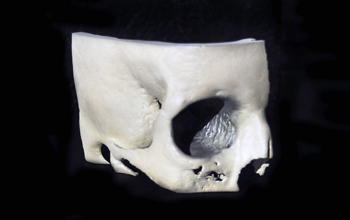Multimedia Gallery
RapidTech 3D modeling (Image 21)
This model of a skull, created at the National Center for Rapid Technologies (RapidTech) for use in a medical study, was made on a 3D printing machine equipped with a stereolithography apparatus (SLA), one of several methods used to create 3D printed objects. Instead of extruding ink or some other liquid onto a surface, such as with an inkjet printer, SLA machines begin with an excess of liquid plastic, some of which is cured, or hardened, to form a solid object.
RapidTech, an Advanced Technological Education (ATE) center located at the University of California, Irvine, and funded by the National Science Foundation (NSF) and Saddleback College, helps researchers and entrepreneurs swiftly design and build product prototypes. The center has more than 20 pieces of equipment that help both academia and industry adapt modern manufacturing technologies to civil engineering, biology, the arts and other areas that don't typically take advantage of such techniques. It has already produced everything from medical devices to architectural models to entertainment items, as well as serviced traditional sectors such as aerospace and automotive. [Image 21 of 26 related images. See Image 22.]
More About This Image
RapidTech seeks to develop and advance additive manufacturing and related technologies. While the center's primary purpose is teaching students advanced manufacturing techniques and providing low-cost help for businesses, it also specializes in 3D modeling, where users can design and perfect a prototype quickly.
For the modeling process, a printer uses digital input from a computer to create a 3D solid object that forms in thin layers. To create the object, a printer head exudes a small amount of plastic or other material while making several passes, creating a new layer with each pass, until a recognizable form begins to take shape. In addition to saving time, the modeling process saves money by eliminating the step of forging a metal prototype -- and possibly repeating the procedure one or more times to correct imperfections.
Both academia and industry use RapidTech's equipment, adapting modern manufacturing technologies to civil engineering, biology, the arts and other areas that don't normally use this type of technique. For example, Airflow Systems, a small business that designs, builds and sells FAA-certified aircraft equipment, needed vintage aircraft parts that hadn't been produced in decades. The parts were for a 1938 Japanese Zero fighter plane slated for inclusion in a restoration project at an aviation museum in Oregon. Working with the original parts, which were pitted, corroded and incomplete, each piece was scanned, defects were corrected and a 3D representation was produced.
RapidTech has also helped commercial businesses. The center assisted the water sports equipment company Hobie Designs Inc. with developing a carbon fiber paddle based on a partial design, which the lab was able to extend across the entire item. "The 3D scanning, computer-assisted design and prototyping process helped us deliver this new concept as fast as we could conceive it," said Hobie Designs President Jeff Alter.
And a movie studio in North Hollywood that designs characters for video, animation and films such as "Shrek" and "Harry and the Hendersons" has worked with RapidTech a number of times to create digital sculptures. The studio owner stays in touch with RapidTech to keep abreast of new technologies available using 3D printing, thus gaining an edge in a very competitive field.
These are just some examples of how rapid prototyping, which is emerging as a core-enabling technology, is supporting the design, development and manufacture of numerous products. [Research supported by NSF grant DUE 11-04305.]
Credit: RapidTech
See other images like this on your iPhone or iPad download NSF Science Zone on the Apple App Store.
Images and other media in the National Science Foundation Multimedia Gallery are available for use in print and electronic material by NSF employees, members of the media, university staff, teachers and the general public. All media in the gallery are intended for personal, educational and nonprofit/non-commercial use only.
Images credited to the National Science Foundation, a federal agency, are in the public domain. The images were created by employees of the United States Government as part of their official duties or prepared by contractors as "works for hire" for NSF. You may freely use NSF-credited images and, at your discretion, credit NSF with a "Courtesy: National Science Foundation" notation.
Additional information about general usage can be found in Conditions.
Also Available:
Download the high-resolution JPG version of the image. (1.3 MB)
Use your mouse to right-click (Mac users may need to Ctrl-click) the link above and choose the option that will save the file or target to your computer.



